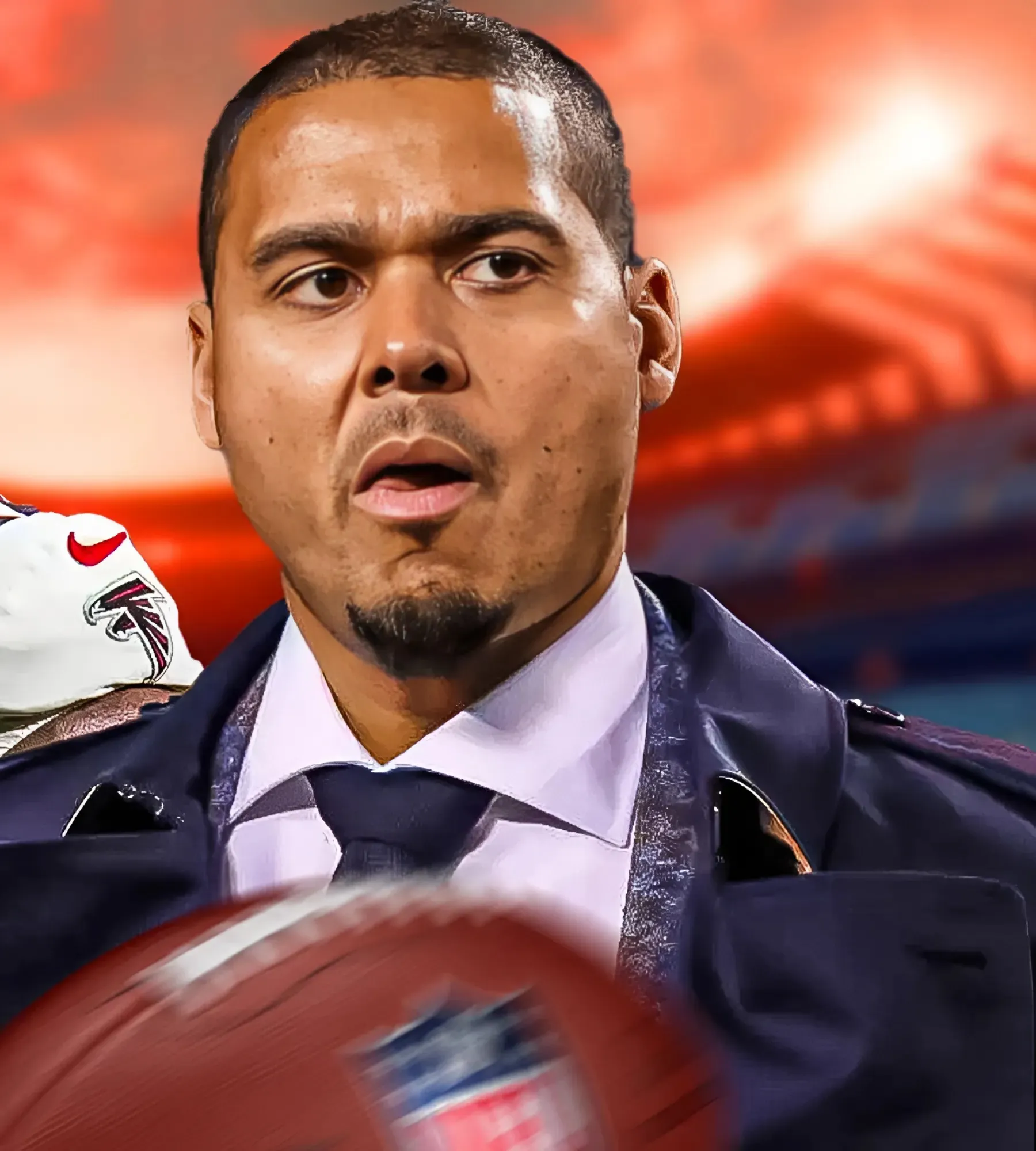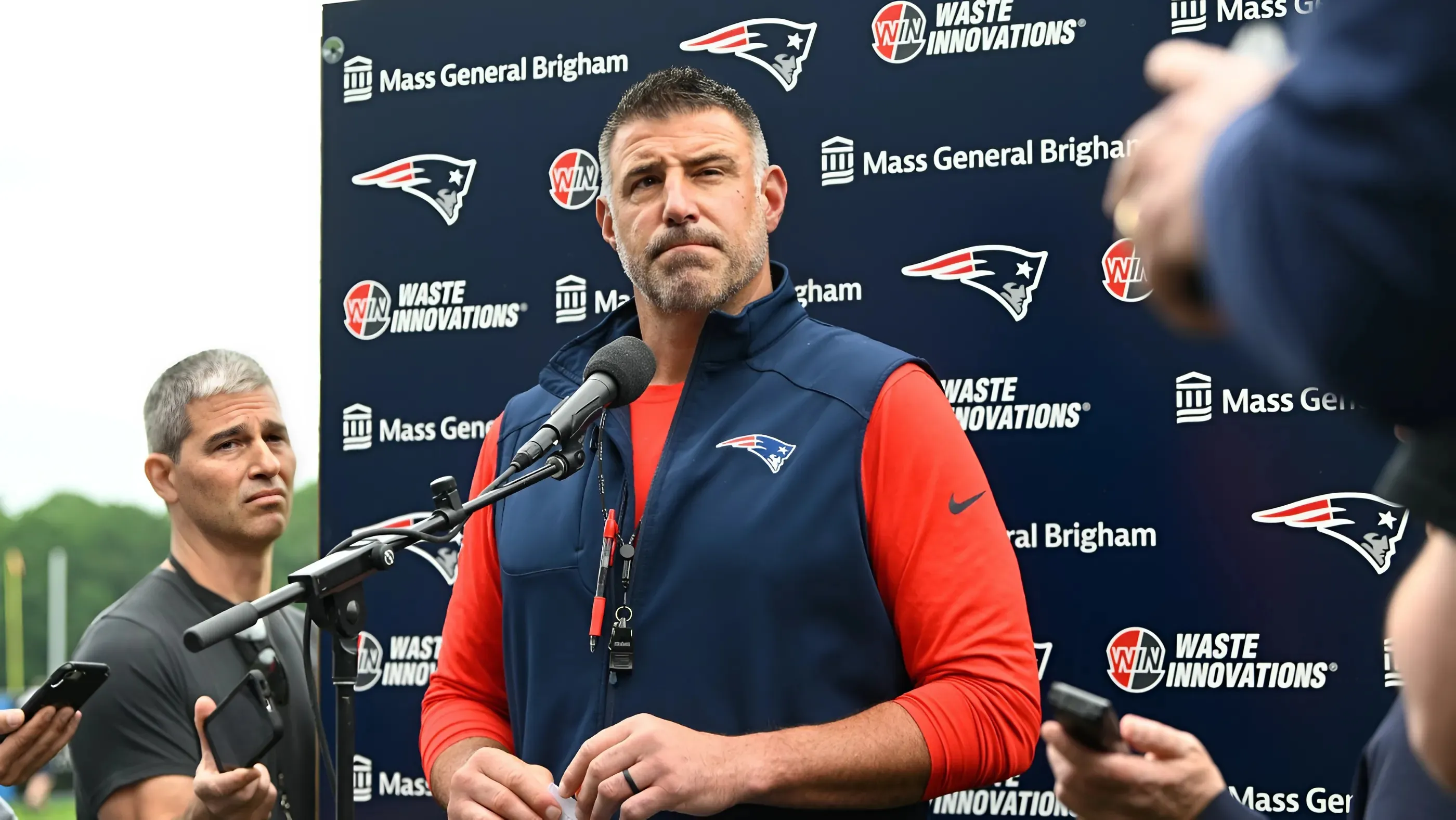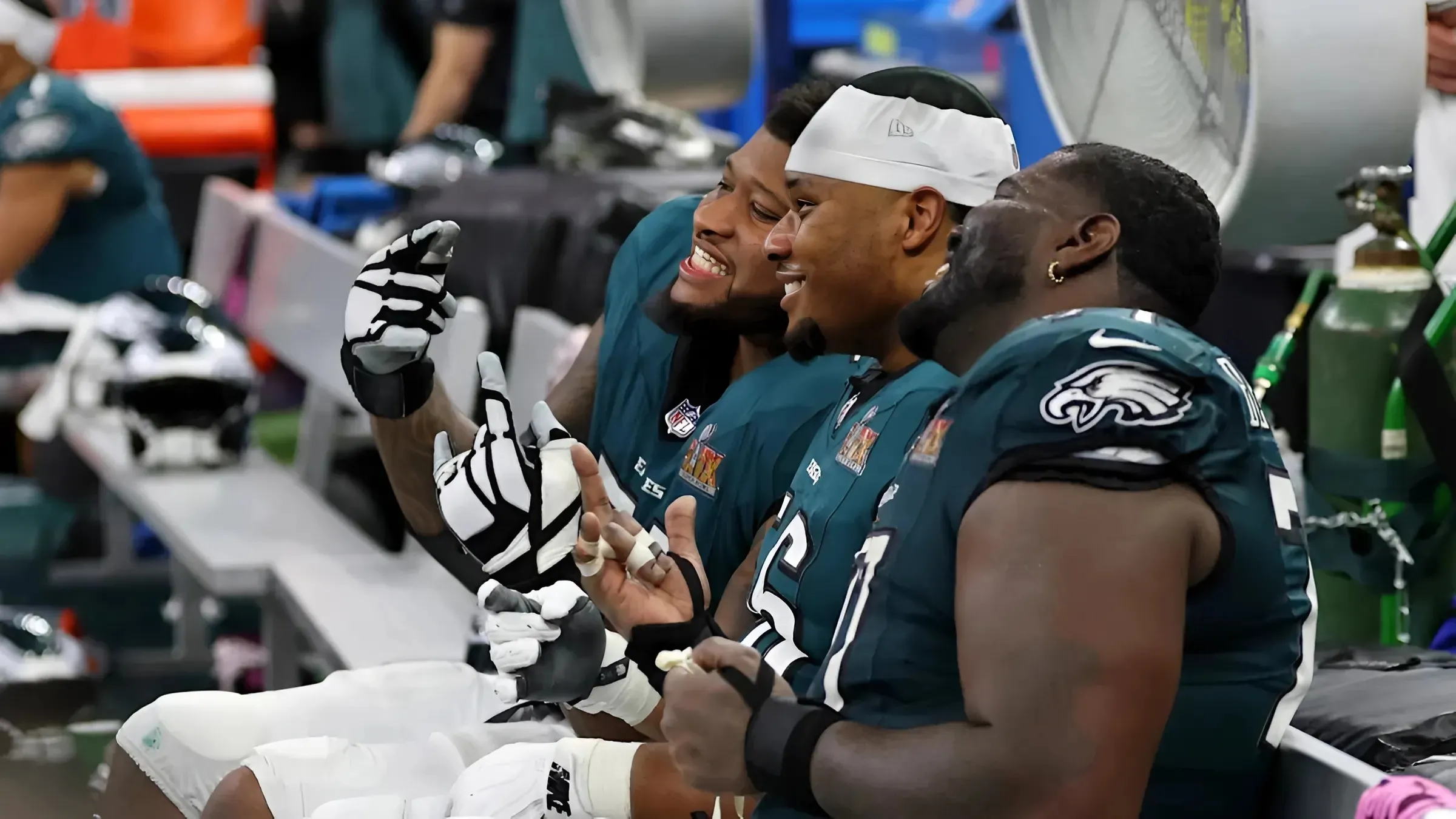The 2025 Stanley Cup Playoffs continue, and the Vancouver Canucks fanbase continues to hold their collective breath for the real offseason to begin.
Then, a promised summer of change can take place, and the roster of the 2025/26 Canucks can start to take shape. Before we get to the acquisitions and departures, however, there’s plenty that can be said about the roster that already is – and how much of it is likely to stick around for the next campaign.
The Canucks had an awful lot of players suit up for them in 2024/25. A full 36 different skaters and four different goaltenders, for a grand total of 40 individuals, hit the ice for the Canucks this past season. Naturally, a number of those individuals were prospects who started out the year as members of the AHL’s Abbotsford Canucks. And each of those players, in turn, has designs on making a more permanent home for themselves in Vancouver for 2025/26.
One factor that will play an important role in determining who makes the cut? Waivers. The summer of 2025 is also a summer in which a number of Canucks players and prospects will see their waiver exemptions run out, making them newly eligible for the waiver wire as of Training Camp 2025. And that can’t help but to influence roster-related decisions.
Waiver exemption and eligibility is determined by a somewhat-complicated array of thresholds related to when a player signed their first contract, how many seasons have passed since them, and how many NHL games a player has played in that time. In short, the earlier a player signs, the higher the thresholds.
For games played, the threshold is typically between 60 and 160. For seasons passed, it’s between two and five, or up to six for goaltenders. Everyone’s ‘waiver clock’ is a little different, but everyone’s runs out eventually all the same.
Here, courtesy of our friends at PuckPedia, is where the Canucks’ various waiver-exempt individuals stood as of the conclusion of the 2024/25 hockey season:
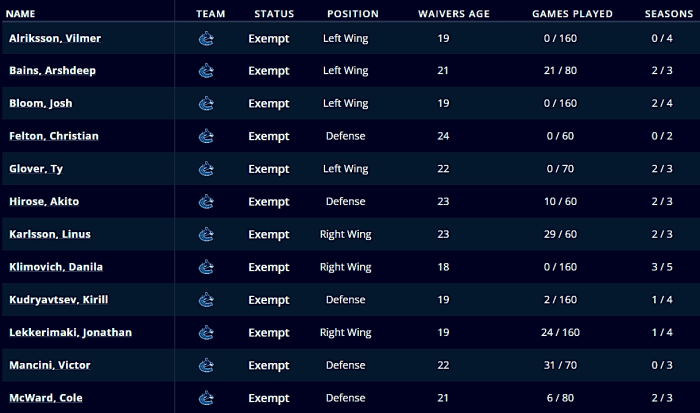
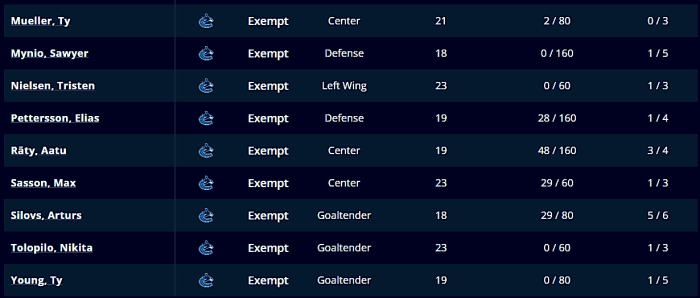
From PuckPedia
As one can clearly see from that chart, waiver eligibility can range quite wildly depending on that first ELC. And as one can also see, a number of key Canucks’ assets will see themselves become waiver-eligible as soon as the puck drops on 2025/26. They are…
Arshdeep Bains
As of yet, Bains has only played 21 NHL games for the Canucks. But he’s just completing his third AHL season with Abbotsford, and because he signed his ELC at age 21, three years is all he gets.
Starting with July 1, 2025, Bains will become newly eligible for waivers. We won’t repeat what this means for each player, but we will for the first on our list: it means that Bains would have to be placed on the waiver wire and made available to every other NHL team before he could be assigned to the AHL again. That’s true whether the reassignment happens during the summer, during training camp, or at any point thereafter.
Bains will be in a concerted battle to make the Canucks’ roster out of camp next year. That said, he doesn’t strike us as a major risk of being plucked by another team. His changed waiver status might play a small role in any decision-making related to him, but not a major one.
Ty Glover
Glover is a prospect who slips under a lot of radars. He’s been with the Abbotsford Canucks for two seasons now, but signed his ELC with the Pittsburgh Penguins back at the age of 21 before being traded to Vancouver with Mark Friedman for Jack Rathbone and Karel Plasek.
Add in that first AHL season with the Wilkes-Barre/Scranton Penguins, and Glover is now at three-out-of-three professional seasons, and will thus also be eligible for waivers as of July 1, 2025. It doesn’t impact his chances of making this particular Canucks roster much, however.
Akito Hirose
Hirose has become a bit of a forgotten one after two quiet, injury-laden seasons with Abbotsford. But he, too, has run out of waiver-exempt time.
Hirose’s situation is a little more complicated. He signed his ELC as an NCAA free agent at the fairly advanced age of 24. That ELC was a one-year deal, and it was ‘burned’ by Hirose playing seven NHL games for the Canucks at the tail-end of the 2022/23.
We’d rather not relive our Hirose hype days. But combine that ‘season’ with his subsequent two in Abbotsford, and that puts Hirose at three-out-of-three professional seasons and renders him eligible for waivers as of July 1, 2025. And as an LD with very little chance of cracking the 2025/26 blueline, he’ll almost certainly be hitting that wire at some point.
Linus Karlsson
We reach our first potentially-consequential waiver eligibility switch here. With Karlsson, the perception is almost the opposite as with some of the previous players listed – he’s been around so long, how is he just running out of waiver exemption now?
The truth is that although Karlsson was drafted way back in 2018 and traded to the Canucks in 2019, he didn’t sign his ELC until the summer of 2022 at the age of 22.
Since then, Karlsson has split three seasons between Abbotsford and Vancouver, and those three seasons are all the waiver exemption he gets.
As of now, Karlsson is probably at least penciled in to the Canucks’ 2025/26 lineup. But as more players get added to the mix, he’ll have to fight to maintain that spot. If he doesn’t make the cut, he’ll now have to go through the waiver wire. Karlsson is also the first player on the list we’d be worried about another team claiming. If anything, this gives him a slight edge in any theoretical close competition with a waiver-exempt teammate.
Cole McWard
McWard falls into the same category as Hirose, which makes sense, as they were signed at around the same time. McWard signed his two-year ELC at age 22 – which is young for an NCAA free agent, but old for a prospect in general. He then burned the first year of the ELC with five NHL games for the Canucks at the tail-end of the 2022/23 season, just like Hirose.
Two seasons in Abbotsford have transpired since without McWard getting another chance in Vancouver. Those three ‘seasons’ bring an end to his waiver exemption, and as of July 1, 2025, he’s got to go through the waiver wire to get back down to Abbotsford.
Though McWard has only six NHL games to his name, he is a right-shooting defender who can skate, and that always makes a waiver claim possible, especially if another team experiences a RD injury or two in the preseason. It’s also possible that McWard just starts the season as the Canucks 4RD, and here his new waiver eligibility could actually help tip the scales in favour of his making the cut.
Aatu Räty
Räty is the highest-profile prospect on this list, and his situation is a little different. Drafted by the New York Islanders in the second round of the 2021 Entry Draft, Räty was signed to an ELC a few months later, still 18. Normally, a player signing at 18 would receive five years of waiver exemption. But Räty then stayed for most of the 2021/22 season in Finland, only coming over to North America for the very end of the Bridgeport Islander’s AHL campaign. This meant his waiver clock didn’t start ticking until he was already 19, leaving him with four years of exemption – and with 2021/22 now counting as one of them!
Räty would split 2022/23 between New York, Bridgeport, Abbotsford, and Vancouver. He’d spent 2023/24 entirely with Abbotsford, and then split last season between the AHL and NHL. That brings him to the end of his waiver exemption as of July 1, 2025.
But fret not. There’s absolutely no way the Canucks would risk placing a player as useful as Räty on waivers. He was already very likely to make the Canucks’ opening night roster on his own merits. The fact that he’s newly-waiver-eligible just cements that status.
Arturs Silovs
Goalie waiver rules are weird, and in general, they get a longer clock, because goalies tend to develop slower than skaters.
Silovs has had a strange path. He was drafted in the sixth-round of the 2019 NHL Entry Draft and then signed right away, which is unusual in and of itself. That left him with six full pro seasons of waiver exemption, but the clock also started ticking immediately.
He joined the Barrie Colts for the 2019/20 season, which counted as the first of the six. He spent the COVID-laden season of 2020/21 playing all over the place, including on the Canucks’ taxi squad and four games with the Manitoba Moose. The 2021/22 season wasn’t much better, with Silovs playing 10 games for the Abbotsford Canucks and 10 more for the Trois-Rivieres Lions of the ECHL.
It wouldn’t be until 2022/23 that Silovs would settle into a permanent spot in Abbotsford, where he’s been for the last three seasons running, interrupted only by occasional stints in Vancouver. That brings him to Professional Year Six-of-Six, and the end of his waiver exemption.
And this one definitely matters. As of now, the plan is probably to have Thatcher Demko and Kevin Lankinen share the Canucks’ crease in 2025/26. But Silovs has had one heck of a season down in Abbotsford, and is currently dominating the AHL playoffs. Would the Canucks really want to risk passing him through waivers during Training Camp, knowing how dry the leaguewide goalie market is right now? Or is Silovs’s loss of waiver exemption all the more reason to trade one of Demko or Lankinen this summer?
Either way, it is Silovs’s waiver status that promises to have the greatest impact on the Canucks and their upcoming offseason decision-making process.
Others Worth Mentioning
That’s the end of the list of Canucks who will see their waiver eligibility automatically change as of July 1, 2025. But there are a couple others worth mentioning who may hit their ‘NHL games played’ thresholds in the course of 2025/26, and who will instantly lose their waiver exemptions the moment they do.
Victor Mancini is completing his first professional season, and what a first professional season it has been. That would normally leave him with two more seasons of waiver exemption, but Mancini has also already played 31 of his 70 maximum NHL games. As soon as he plays his 39th NHL game of the 2025/26 season – a number he seems likely to hit – Mancini loses his waiver exemption.
The same goes for professional sophomore Max Sasson. He technically has another pro season to go until he loses his exemption, but only has a games-played threshold of 60, and has already played in 29 of them. With 31 more NHL games, Sasson loses his exemption – or, he does automatically as of July 1, 2026, whichever comes sooner.
